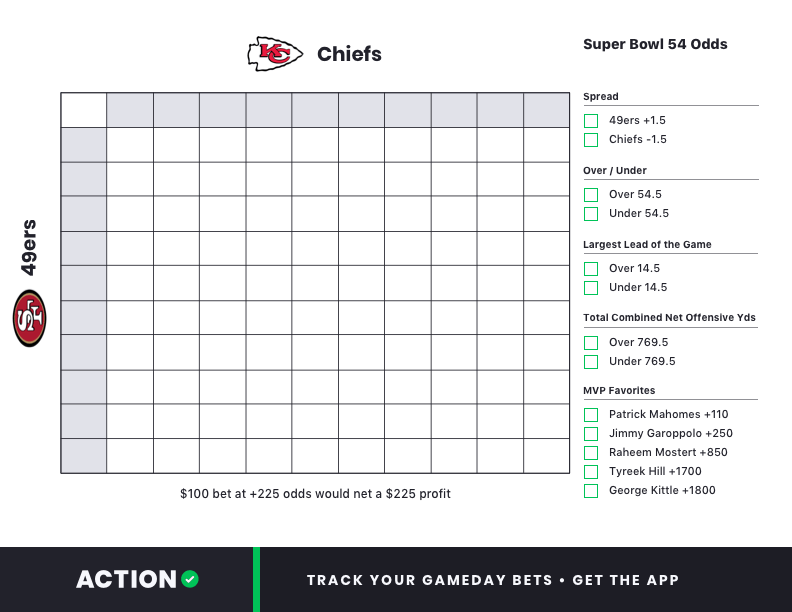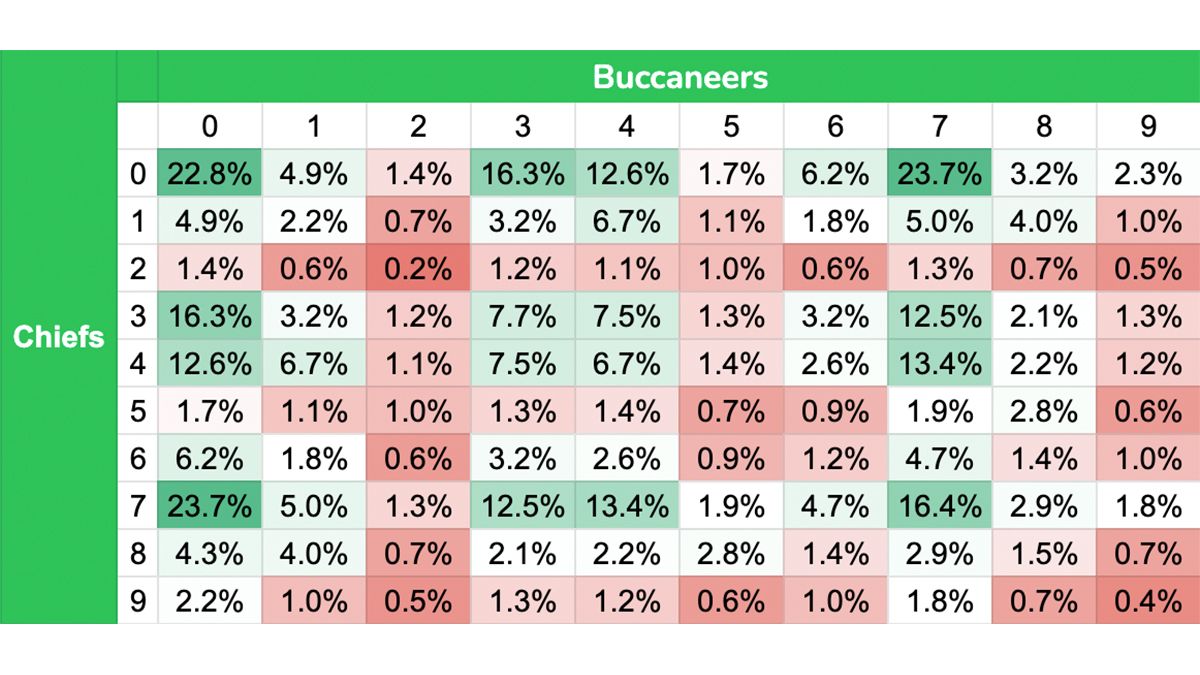Betting On Squares
There is no perfect science to picking a square, because the numbers down the 'home team' row and 'visiting team' column are drawn at random. But keep in mind that if you pick multiple squares in. SPORTS BETTING AT BETONLINE.AG SPORTSBOOK. BetOnline.ag is more than just an online betting platform. We boast a 'focus on the player' approach and have built our reputation on offering clients nothing but the best, from cutting-edge technology, enticing promotions and the latest sports betting odds. Bettors are made aware of a per-square buy-in price ($1 for example). A bettor can purchase as many squares as they wish and they add their name in one of the 100 boxes on the 10 x 10 square. After the entire sheet is filled, a method to label each column and row with a number is formed. Typically, winnings for Super Bowl squares are determined at the end of each quarter, based on the final digit of each team’s score. For exampled, if the Bucs lead 14-10 at the end of the first.
Have you ever heard the expression that a team is “sharp” or that a team is “square?” Today, we’re going to look at what the difference is between a sharp team and a square team and why you want to be on the sharp side of things as often as possible.
Defining “Sharp ” and “Square”
Sharp Betting
Being a sharp bettor is one that is considered to be a long-term winner in sports betting. This might seem elementary in and of itself, because not every winner is a sharp, and not every loser is a square. It takes winning over the course of thousands, if not tens or even hundreds of thousands of plays on a consistent basis to make you a truly sharp bettor. Generally speaking, sharps are on the right side of a bet, and significantly more often than not, the plays that they make are going to be the right ones.
“Right ones” though, aren’t always winners. We’ve all been on the wrong side of that horrifying beat, and though it probably does all level out in the end, all too often, the team that hits the backdoor for a cover at the end of the game or a team that gets tremendously lucky to beat the spread was a square team, not a sharp one.
Square Betting
On the contrary, just because you lose doesn’t mean you’re a square, and just because you win doesn’t mean that you aren’t a square. Square bettors though, are typically the ones that believe that they should be able to win 70% or 80% of their games. Of course, we know that in the long run, that’s a legitimate impossibility, as even the best of bettors only win in the mid- to high-50%s of their games, and they make awesome money doing so.
Finding Sharp Bets
It is considered to be sharp money when “a wager initiates a line change… regardless of the amount bet.” There are several respected bettors, particularly in Las Vegas, who can move betting lines all by themselves.
However, there is a lot more to finding sharp bets than just seeing when lines move. In fact, often times, when lines move, squares are forcing those lines to move, particularly around key numbers. Keep a close eye on a football game with a betting line of 4.5 or 5. There isn’t all that much difference, mathematically speaking, between a four-point game and a six-point game in the NFL in particular, and bettors who are willing to bet -5 will be just as willing to bet -5.5. This is where the sharps can strike, though.
If over 65% of bettors are on one side, especially if that 65% side is the favored side, and the line either is staying stagnant or is moving in the direction of the 35% side, there is a good chance that the 35% side is the sharp one.
Sharp Trends To Watch
General casual bettors like betting on favorites. Typically, they’re the better of the two teams on the field or court that day, and bettors like to know that they are betting on the better team. However, there are some definite surefire ways to identify sharp bets. This isn’t always the case 100% of the time, but here are some trends to look for if you’re trying to be a sharp bettor.
Home Underdogs
A study by Steve Levitt shows that players bet on home favorites 56.1% of the time, while home underdogs represent just 31.8% of all bets made on a game. By definition, the road favorite is the most popular bet, as 68.2% of all bets in his sample set were made on road favorites. However, in actuality, home underdogs cover around 53% of their games across college football, college basketball, NBA basketball, and the NFL, which covers by far the mass majority of betting across all of sports.
People hate betting on home underdogs because they are always the lesser of the two teams, and the public forgets to factor in home field advantage. The first instinct is that the New England Patriots are going to beat the New York Jets a huge percentage of the time regardless of where the game is being played, but that just isn’t the case all the time. Factor in New York getting perhaps 3.5 points to get started in a game, and watch as square bettors cringe when the Pats win the game by three points.

Unranked Teams Favored Over Ranked Teams
This works with both college basketball and college football, and it is particularly useful in bowl games for college football as well. This is a strategy used by a number of the top bookies in the game, and if blindly used, turns a profit virtually every single season. When a team is unranked and playing against a ranked team, and the squad without a number next to it is favored, the unranked team is almost always the one to bet, assuming that there aren’t huge injuries involved that the public knows about.
This strategy works quite a bit when you’re talking about minor college basketball as well when we aren’t talking about ranked teams vs. unranked teams. That 19-11 team in a small conference that is just mowing down teams left and right very well could be a small underdog to a 13-17 team from that same conference because it is a road game for the 19-11 squad. Don’t just blindly take that 19-11 team just because it is the “better team.” Do your research and compare home and away splits, and you’ll see what sharp bettors are always seeing: The 13-17 team is almost always going to be the right side and will cover at least 55% of the time.
The most common football pool is the standard 100 square football pool. At almost every Super Bowl party you have ever been to you might have seen this 10 x 10 betting sheet and wondered what it is. There’s nothing like a friendly little game to liven up the party during the Super Bowl. This pool is built around a simple chart calls for no skill or previous knowledge of how to bet the spread or of the game of football in general. In this article I will explain how easy this to partake in and how much fun this form of gambling on football can add to the game.
How a 100 square football pool works is very simple. Whoever the party host or pool host may be creates at 10 squares by 10 squares chart; this is numbered on each axis from 0-9. Each axis is also labeled home/away or by each team playing, if chosen.
Betting Squares App

The pool host will then try to sell each square on the chart, usually ranging from $5-$100, depending on the type of clientele buying the squares. After all the squares have been sold, each box is then assigned at random so that everyone has a fair chance to get a coveted square. Another method some pool hosts use is to have all the entrants write their names down inside a single square of their liking on the blank 100 square pool sheet and then use 10 cards (Ace through Nine) to randomly draw the numbers at the top and side of the pool sheet.
How do you know which squares are the best? This is simple, so the way this works is that every square on the board will assign two numbers. For instance, if you had a square in the middle of the board, this would correspond to 5 for the home team and 5 for the away team. So what do those 5’s mean?
Betting On Football Squares
The numbers 0-9 correspond to either the last number in the home or away team score depending on where the square is located. So 20 points would be a 0 whereas 35 would be 5 points.

So how do you win? At the end of the first quarter, halftime, third quarter, and final score whatever the score is will be awarded to the person who owns that square. If the score is 17-10 at the half with the home team winning, the person with the squares of 7 and 0 would win that portion of the game. Having the squares 0 and 7 would not help because it would be assigned to the wrong teams. Usually the total money is divided by 5, and is paid out as follows. 1st quarter, Halftime, and 3rd quarter all get a 1/5 of the total bank and the Final Score doubles this to 2/5. So if you were involved on a $5 dollar pool and all 100 squares were filled that would be $500 to be paid out. With that number you would get paid $200 for final score and $100 for all other scores.

Betting Squares For Super Bowl
Which numbers are the best to have when entering the office pool? The top 5 most common scores for NFL games since 1970 are 20-17, 17-14, 27-24, 13-10, and 24-17. So as you can see if one of your numbers is 0, 3, 4, or 7, then you already have a leg-up on the competition.